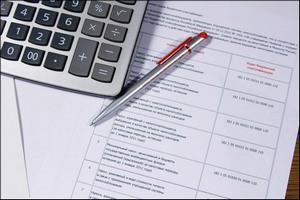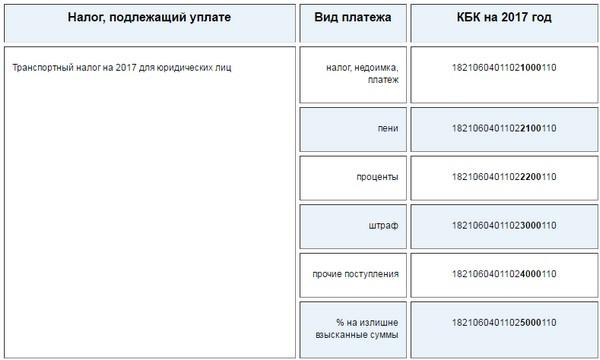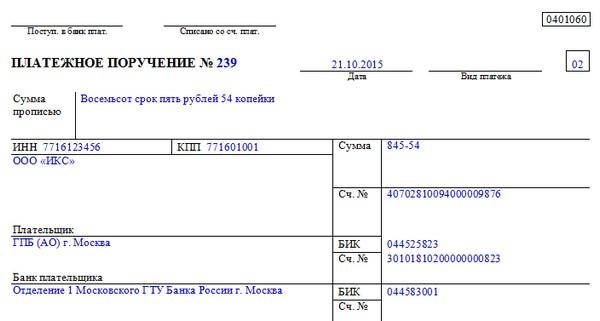KBK state duty and what does it mean?
The budget classification is designed to sort the sources of income and expenditure of budgets. Each source is assigned an identifier, or KBK. The administrator of the payment and the reason for the transfer of funds are encrypted in it. KBK is used to pay taxes, duties, social payments, penalties and delays on them.
KBK - features and purpose
The budget classification code (BCC) is a requisite that allows you to clarify the ownership of payments sent to the budget of any level of government, government agency or organization. It is indicated in payment orders in column No. 104 for making the following deductions:
- tax payments (income tax, land tax, personal income tax);
- state fees (going to court, editing constituent documents);
- contributions to funds (pension, social, medical contributions);
- penalties and penalties imposed by the FTS (Federal Tax Service), FCS (Federal Customs Service), traffic police or other state organizations;
- taxes under the simplified and imputed taxation system;
- other payments to state organizations - payment for telephone services, extracts from Rosreestr, etc.
Dear Readers! The article talks about typical ways of solving legal issues, but each case is individual. If you want to know how solve your problem- contact a consultant:
+7 (499) 350-63-18
(Moscow)
+7 (812) 627-14-92
(St. Petersburg)
It's fast and is free!
The concept and purpose of the KBK is enshrined in article 18 of the Budget Code of the Russian Federation. According to the code, the use of a system of codes makes it possible to group income and expenditure of budgets of all levels. The Ministry of Finance of the Russian Federation is responsible for drawing up an up-to-date list of the KBK.
KBK - where to indicate?
Standardized payment order forms are used to pay taxes, insurance premiums and fees. The rules for filling them out are noted in Appendix No. 2 to the Order of the Ministry of Finance No. 107n of 2013.
A separate payment order is created for each tax. The budget classification code is entered in column 104; without the entered code, the order is not accepted for payment.
Knowledge of the code is also required to fill out the Unified Calculation for Insurance Premiums, which must be provided to the Federal Tax Service Inspectorate every 3 months. It contains the following data:

The KBK will be needed to fill out the 2015 3-NDFL declaration form. It is indicated in Section 1, which contains data on the amount of tax.
KBK - how many signs and what do they mean?
The BCC consists of 4 semantic parts, each of which denotes information about the payment being made. In total, the code includes 20 characters.
As an example, let's take the code for paying income tax - 182 1 01 01011 01 1000 110.
The first 3 characters indicate the place where the payment is intended. In this case, the FTS (Federal Tax Service) code is used - 182.
The next 10 characters indicate the type and category of income. They are divided into several levels:
- group;
- subgroup (income taxes - 01, social contributions - 02, product tax - 03, etc.);
- article and sub-article (elements fixed in legislative acts, fixing the lists of budget revenues and expenditures);
- code of the budget level to which the payment is directed (federal budget - 01, regional - 02, local - 03, urban district - 04, etc.)
Income tax refers to 1 group (income), 01 subgroup (income tax), is transferred to the state (01) or regional (02) budget.
Symbols from 14 to 17 indicate the purpose of the payment - payment of tax (1XXX), penalty (2XXX) or fine (3XXX).
The last 3 characters are the economic income classifier. The following codes are used for tax payments:
- taxes (110);
- profits from owned assets (120);
- paid services rendered (130);
- penalties and fines listed at the request of the tax authorities (140);
- social payments (160).
How to find out the BCF of an organization?
The current codes are developed by the Ministry of Finance. The codes are periodically changed and updated, up-to-date information is posted in the form of an order on the Ministry's portal in the section "Taxation in the Russian Federation". The main details for drawing up papers for the payment of taxes, state duties, penalties and fines are also indicated there. The last changes were made to the table in the summer of 2016 and are valid from the beginning of 2017.
KBK on taxes and insurance premiums in 2017
The latest changes took effect on January 1, 2017. According to order No. 230n of December 7, 2016, all powers to collect and record insurance, medical and pension contributions are transferred to the Federal Tax Service (FTS). The tax service took over control over the calculation of the organizations' contributions, compliance with the payment deadlines and the collection of penalties. Payment orders for them will be filled in the same way as tax ones.
For those who pay additional pension contributions, 2 different BCCs have been introduced for tariffs charged under difficult working conditions and for tariffs that do not depend on labor conditions.
Contributions for assistance in case of injuries and accidents at work will remain under the purview of the FSS. Consequently, the administrator code 182 (FTS) is entered in the BSC for all types of social contributions, and the indicator 393 (FSS) remains for contributions for injuries. Since 2017, a modified 4-FSS reporting form has been in effect. You need to hand it over once a quarter.

To avoid confusion, the Ministry of Finance adopted an order to combine the code of the minimum tax and the tax on the difference between income and expenses for organizations on the simplified system. Therefore, according to the new rules, KBK 182 1 05 01021 01 1000 110 is used in the documents. The advance payment made will be counted towards the payment of the minimum tax.
Since 2017, foreign organizations submitting reports to the IFTS have used a separate code for paying income tax - 182 1 01 01 01080 01 1000 110.
Filling in the KBK in payment orders in 2017
The following details are filled in the payment order:
Information about the taxpayer - the name of the company, division, the name of the individual entrepreneur, details (TIN and KPP), information about the inspection to which the payer is attached.
- 101 - payer status. The following statuses are possible: 01 - organization or other legal entity, 09 - individual entrepreneur, etc.
- 104 - KBK details.
- 105 is the numerical number of the municipality indicated in the classifier of the territories of municipal formations (OKTMO).
- 106 - the reason for the payment. In this field, an alphabetic abbreviation is put, for example, for a tax or contribution in the current period - TP, for repayment of arrears before the request of the Inspectorate of the Federal Tax Service of our own free will - ZD, for repayment of the debt identified by the inspection act - AP, after receiving the inspection request - TR, for contribution for emergencies at work - Oh, etc.
- 107 - period and date of payment. The date until which you need to make the payment, the deadline for the deferral, etc. If no date is provided, 0 is set.
In the case of payment of a fee or tax, as well as arrears on them before the receipt of the claim, an abbreviation is put before the date indicating the frequency of payment - MS (monthly), CV (quarterly), PL (semi-annual) and GD (annual). Next, a dot is put, the period (month, quarter) is indicated, then a dot and a year. The record looks like this: "MS.06.2017". For payments made annually, zeros are put in the middle: "ГД.00.2017".
- 108 - details of the papers justifying the payment. This can be a demand to pay tax, decisions to defer or restructure debt, a court decision. In the absence of a document, 0 is set.
- 109 is the date, month and year that the justification document is dated.

22 "Code" - the identifier of the accrual, or UIN. If there is no UIN in the requirement or other justification document, 0 /// is set. When filling out the PD (tax) form, the index of securities that came from the tax authority is used as the code. In the payment order in the form PD-4sb (tax), the identifier does not need to be indicated.
The BCK is filled incorrectly. What to do?
If a mistake is made in the KBK, this is not considered the basis for calculating fines and penalties. According to the letter from the Ministry of Finance and data from the Federal Tax Service, the tax payment is considered complete as soon as the organization pays the amount of the payment to the bank, post office cashier or administration. Tax obligations are recognized as not fulfilled only in cases where the required amount does not arrive at the account of the Federal Treasury, for example, due to the revocation or return of a payment order, an error in the bank details, or the Treasury account number. An incorrectly indicated BCC does not prevent the transfer of the payment to the account, therefore the payment is considered executed.
If the BCC is indicated incorrectly, you should contact the tax office to which the taxpayer is attached, with a statement about the error and a executed payment order proving the fact of payment of the tax.
Conclusion
The KBK is a requisite required for filing reports with the tax office, as well as transferring any payments to a government agency. It is used to fill out payment orders, tax reporting forms and calculate social contributions. The code consists of 20 characters indicating the organization to which the payment is sent and the type of transfer. The list of valid codes is on the website of the Ministry of Finance, it is constantly changing and updated. The updated list comes into effect in the next tax period.
In contact with
